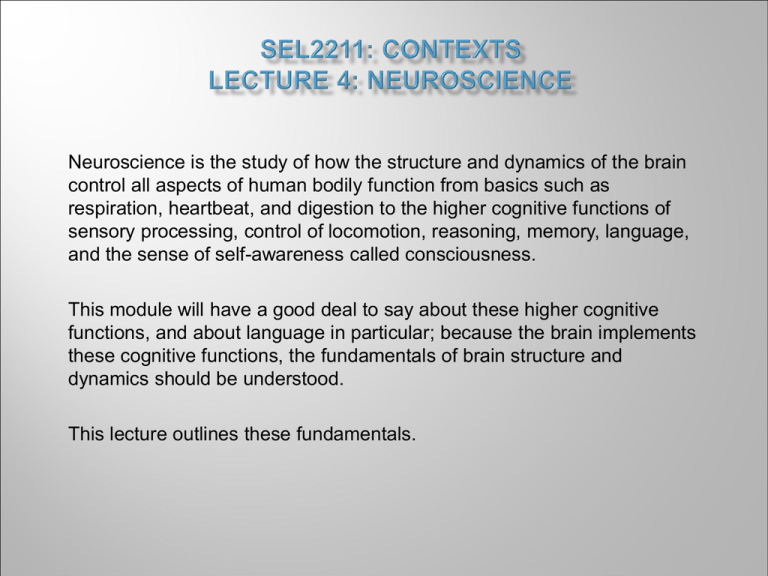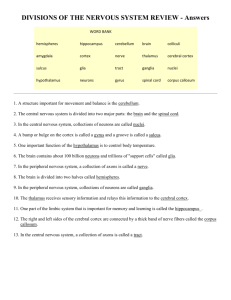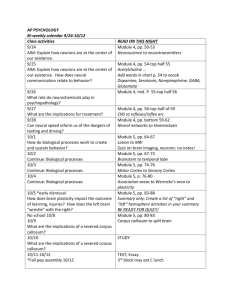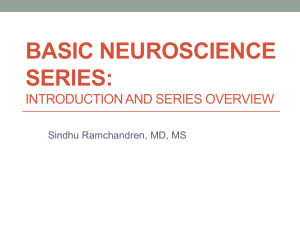Powerpoint
advertisement

Neuroscience is the study of how the structure and dynamics of the brain control all aspects of human bodily function from basics such as respiration, heartbeat, and digestion to the higher cognitive functions of sensory processing, control of locomotion, reasoning, memory, language, and the sense of self-awareness called consciousness. This module will have a good deal to say about these higher cognitive functions, and about language in particular; because the brain implements these cognitive functions, the fundamentals of brain structure and dynamics should be understood. This lecture outlines these fundamentals. 1. History of neuroscience Though it seems self-evident to us, the realization that the brain is the physical organ that underlies cognition is fairly recent. The ancient Egyptians thought that the heart was the seat of human intelligence and routinely removed the brain in the course of mummification, presumably on the grounds that the owner wouldn't need it in the next life. By the 6th century BC some Greek philosophers had come to the view that the brain was the place where the mind was located, though no less a thinker than Aristotle still took the Egyptian view and regarded the brain as a cooling mechanism for the blood. In Roman times the philosopher Galen (c.129-200 AD) based his view that the brain controls bodily function on dissection of animal brains, though like his predecessors he continued to believe that the brain was the 'seat' of a nonphysical substance or entity which endowed living creatures with their cognitive functions. 1. History of neuroscience During the Middle Ages (c.500 - c.1500 AD) the emphasis was on the nonphysical basis of cognition, the soul, and little or no progress was made in study of the brain. With the renewed interest in empirical science during the Renaissance, however, interest in the brain revived. The anatomist Andreas Vesalius (1514-64 AD) emphasized the importance of dissection as a means of understanding the human body as a physical mechanism; he published a detailed account of the brain's anatomy, and correctly proposed the nerves as a means by which the brain controlled bodily functions. History of neuroscience The polymath philosopher, mathematician, and scientist René Descartes (15961650 AD) developed a view of the relationship between the mind and the body that has been highly influential ever since and continues to vex philosophers of mind as the 'mind-body problem': 1. that the physical body (brain included) is a machine, and that the mind / soul, a non-physical substance, inhabits the machine and gives it its cognitive functions. Descartes proposed the pineal gland, an actual brain structure, as the place where physical and non-physical meet. History of neuroscience The first truly scientific advances, in the modern sense of 'science', were made in the late 19th century. 1. For example, Golgi (1843-1926) invented a way of staining brain tissue to reveal that it was made from a dense interconnection of microscopic cells or neurons Ramon y Cajal (1852-1934) made detailed studies of the neural structuring of the brain and proposed the neuron as the basis for all brain function. Hermann von Helmholtz (1821-94) demonstrated that neurons interact with one another electrically. Since then neuroscience has grown rapidly to become a worldwide research discipline. 2. The nervous system The human nervous system comprises the brain, spinal cord, and the network of nerves that branch to all parts of the body. The brain controls the body by means of electrochemical signals which travel to and from the brain via the spinal cord and along the nerves. 2. The nervous system The brain receives input signals from the sensory organs, sends signals to the muscular system to effect bodily movement, and monitors the operation of internal organs like the heart and lungs by two-way signals. The brain and the spinal cord are generally referred to as the central nervous system, and the nerve network as the peripheral nervous system. The remainder of this lecture focuses on the central nervous system and on the brain in particular. 3. Brain anatomy Everyone has seen pictures of a human brain. Here's an example. To quote the website from which this picture was taken, 'The human brain is a 3-pound (1.4-kilogram) mass of jelly-like fats and tissues', which sounds fairly unpromising as the organ which makes us us, but the website goes on to say 'yet it's the most complex of all known living structures'. The present part of the lecture examines this complexity in terms of the brain's main components, the next part looks at its microstructure. 3. Brain anatomy The picture shows three of the brain's main components: the highly-convoluted cortex, the cerebellum on the lower left, and, below the cerebellum, the stump of the brain stem where it has been severed from the spinal cord. Much of the brain's structure is, however, hidden by the cortex; the following crosssectional diagram shows the hidden components. 3. Brain anatomy The various brain components are associated with different functions: Cortex: This is a sheet of tissue whose thickness varies from 2 to 6 mm and which constitutes the outer layer of the brain; it is crumpled to allow it to fit inside skull. Seen from the top, the cortex is divided into two halves joined by a large bundle of nerves called the corpus callosum: 3. Brain anatomy The cortex is associated with the so-called 'higher' cognitive functions: sensory perception, voluntary movement, reasoning, and language. The cerebellum, meaning 'little brain', is like a little version of the cortex. It is associated primarily with control of bodily movement. The limbic system is associated with the emotions and with memory. The basal ganglia coordinate movement. The brain stem deals with fundamental bodily functions over which we have no conscious control, such as breathing and heart rate. 3. Brain anatomy These various components overlap to some degree in terms of their functionality. This is because the human brain is a product of gradual development by evolution; a designer would have given it a more efficient structure. 4. Neurons The human body is made up entirely of different kinds of cells. The cells of the nervous system are called nerve cells or neurons, and these transmit signals to one another and to other types of cell via an electrochemical process. The brain alone consists of about 100 billion neurons. 4. Neurons There are various kinds of neuron, each for a different kind of function, but for present purposes these do not need to be distinguished, and the discussion will relate to a generic neuron. Needless to say, neurons are tiny and can only be seen with the aid of a microscope; the figure below left shows actual neurons in the cortex, and the one on the right shows a schematic of a single neuron. 4. Neurons The cell body receives input signal pulses via its dendrites, and when the number and intensity of such signals reaches a threshold, the cell body starts firing signal pulses along the axon. Youtube. Firing neurons: http://www.youtube.com/watch?v=GIGqp6_PG6k&feature=related 4. Neurons A neuron typically has about 10,000 dendrites, only a few of which are shown above for clarity; the reality looks more like the graphic on the left. Neurons are densely interconnected in the brain. Each axon makes numerous connections with the dendrites of other neurons; the graphic on the right gives an idea of this. 4. Neurons The result is a vast network of neurons sending signals to one another. Youtube. Neuron network: http://www.youtube.com/watch?v=sX87g3AHIbc Youtube. Neurons:http://www.youtube.com/watch?v=sQKma9uMCFk This, and only this, is the mechanism that produces human cognition. 5. Learning The brain is plastic in the sense that the structure of neuronal interconnection can change over time in response to its owner's experience of the real-world environment. This begins at birth as the baby and then child first begins to interact with the world, and continues throughout adulthood until death. It is how skills and information about the world are acquired and stored in memory. This process is otherwise known as learning. 5. Learning Learning occurs at the places where the axon from one neuron connects to the dendrites of other neurons. These connections are called synapses, and the pattern of synaptic connectivity is the mechanism that underlies learning. 5. Learning The brain grows rapidly during the first few years of life, and as it does so each neuron makes numerous new synaptic connections with others in its neighbourhood. At birth a typical neuron in the cortex makes about 2500 synaptic connections, and by the age of two or three this has grown to 5000 on average. Thereafter, the pattern of neuronal connectivity established at this early stage of life is modified in response to experience as we age via a process called synaptic pruning: synapses that rarely send or receive input gradually die, and those that are often used are preserved and strengthened. 6. Brain and cognition We know that the brain generates cognition, and that the higher cognitive functions are generated mainly by the cortex, but how this happens is still a matter for ongoing research. With respect to the cortex in particular, substantial progress has been made in understanding which regions of the cortex are involved in which cognitive functions. In the past this was inferred from observation of the behavioural effects on people with various sorts of brain damage due to disease or accident, and from direct stimulation and removal of different parts of the cortex during remedial surgery such as removal or tumours. 6. Brain and cognition More recently, the development of brain scanning technologies such as CT, PET, and MRI have allowed online observation of brain function in response to various cognitive tasks to be observed without recourse to surgery. These have greatly enhanced our understanding of the relationship between cognitive function and cortical dynamics, that is, of which regions of the cortex are involved in which cognitive functions, and how the pattern of cortical activation changes as cognitive functions unfold over time. 6. Brain and cognition An MRI scanner is shown below. The test subject is placed in the machine so that his or her head is in the opening in the middle of the device and is then given one or more cognitive tasks to perform, in the course of which brain function is observed and recorded. 6. Brain and cognition For example, the figures below shows the effect of a painful injection into the arm on the thalamus and on the cortex. The coloured areas show increased neuronal activation; cognitive functions other than pain perceptual could be similarly observed. 6. Brain and cognition For example, the figure below shows the effect of a painful injection into the arm on the thalamus and on the cortex. The coloured areas show increased neuronal activation; cognitive functions other than pain perceptual could be similarly observed. http://www.youtube.com/watch?v=8oN-sGrPgpI • http://www.youtube.com/watch?v=XwUn64d5Ddk&feature=related • 6. Brain and cognition Based on such results, maps assigning at least some cognitive functions to particular regions of the cortex can be constructed; two such maps are shown below. 7. Brain and language Linguists are, of course, primarily interested in identifying the part or parts of the brain involved in the implementation of human language. Attention has long focused on two small areas of the cortex called 'Broca's area' and 'Wernicke's area'. This is because both were long ago found to be involved on speech production and comprehension. 7. Brain and language In 1861 Paul Broca had a patient who could say only one word: 'tan'. When this patient died Broca examined his brain and noticed damage in the part of the brain shown in the diagram. This has become known as 'Broca's area', and many observations since then have confirmed that this area is indeed involved in speech production. 7. Brain and language That Broca's and Wernicke's areas are demonstrably involved in speech processing does not justify the claim that these are where human language is located in the brain. Current research supports the idea that these two areas have to do with speech motor functions, and that language involves many parts of the brain working in conjunction. The 'Brain and language' links at the end of the lecture provide an introduction to this work. At present, the implementation of important aspects of language such as syntax and semantics in the brain is largely mysterious. 8. The significance of neuroscience for cognitive science and linguistics The central question in any scientific discourse about human cognitive functioning is this: How can the brain, a physical object, generate cognitive function and, in humans, a sense of self-awareness or consciousness? It's a question that this module will be returning to many times in one form or another.








